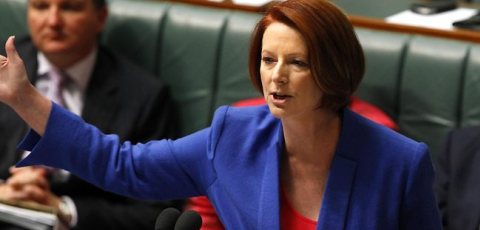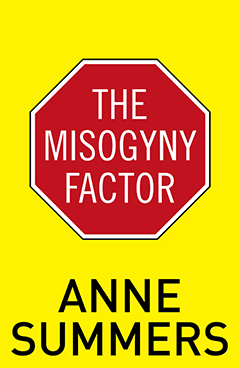
By Sonia Nair.
It’s been an abysmal week for Australian women with a succession of calculated, ugly and unprecedented expressions of hatred catapulting talk of sexism and misogyny to the forefront of social and political discussion.
When Prime Minister Julia Gillard launched the ‘Women for Gillard’ campaign last week and cautioned against abortion again becoming the “political plaything of men who think they know better”, she was decried for cynically and desperately “playing the gender card”. But as journalist Anne Summers noted in her opinion piece on the Drum, abortion IS a federal political issue and Gillard was quite justified in making it an electoral issue.
This was followed by reports of a “grossly sexist” menu said to have been used at a fundraising dinner for Liberal candidate Mal Brough, Soccerroos coach Holger Osieck commenting that “women should shut up in public”, shock jock Howard Sattler questioning Gillard about partner Tim Mathieson’s sexuality and 3AW radio host Dee Dee Dunleavy calling for a boycott of Nigella Lawson’s products until she “takes a stand on domestic violence”. To top it off, Gillard was then condemned by industrial relations consultant Grace Collier for “showing cleavage” in Parliament.
The Misogyny Factor [is] a clear, concise and detailed expose of how far Australia has to go in eradicating the sexist and ultimately misogynistic views that shape and underscore the very fabric of our national psyche.
 Sexism and misogyny – particularly the vitriol directed at Australian women in top positions – may be clearly tangible constructs, yet this week further underlined how grave the discrimination levelled towards women really is.
Sexism and misogyny – particularly the vitriol directed at Australian women in top positions – may be clearly tangible constructs, yet this week further underlined how grave the discrimination levelled towards women really is.
Spurred on by the overwhelmingly positive response she received for her two landmark speeches about women in Australia in 2012, Anne Summers wrote The Misogyny Factor – a clear, concise and detailed expose of how far Australia has to go in eradicating the sexist and ultimately misogynistic views that shape and underscore the very fabric of our national psyche.
Australia may currently have its first female Prime Minister and a female Governor-General, but Summers says the insidious ‘misogyny factor’ continues to persistently shunt many women to the sidelines, internalise long-standing views that men and women are unequal, and make it near impossible for women to break the age-old shackles of perceived inferiority, gendered roles and responsibilities.
“We have made a lot of progress but we have not yet succeeded.”
Armed with sobering statistics and anecdotal evidence – which corroborate the unequal pay gap, low participation rates, lack of accolades, and paltry superannuation account balances that come with being a woman – Summers draws upon her wealth of experience working in both the public sector and as a journalist to further demonstrate how little things have changed for women in the past 25 years.
But perhaps the most shocking finding to emerge from Summers’ dissection of misogyny in Australia was the sheer breadth of unspeakably vile, derogatory and aggressive ways in which the Prime Minister has been attacked, vilified and demeaned by the media and the wider Australian public – treatment tantamount to sexual harassment (outlined in Summers’ 2012 speech ‘Her Rights at Work’, available on her website in the form of a “vanilla version” or “R-rated version”, with examples of distasteful, explicit imagery).
 Many of Summers’ well-substantiated views, disheartening statistics and impassioned pleas for equality are echoed in the anthology Destroying the Joint: Why Women Have to Change the World.
Many of Summers’ well-substantiated views, disheartening statistics and impassioned pleas for equality are echoed in the anthology Destroying the Joint: Why Women Have to Change the World.
In a corpus of thought-provoking, affecting and thoroughly compassionate essays on women’s rights in Australia, a myriad writers touch on a whole range of issues – with Alan Jones’ imbecilic “destroy the joint” comment from August 2012 and Jane Caro’s subsequent Tweet acting as a launching pad into well-elucidated explorations of what it means to be a woman in Australia.
Some of the highlights in the anthology include Yvette Vignando’s vignette of Tweets, Catherine Deveny’s 12 easy lessons in destroying the joint, Corrine Grant’s letter to a feminist (from a man who knows better), Susan Johnson’s fictional piece on the life of an oppressed woman and Krissy Kneen’s deliciously entertaining and semi-autobiographical story of the double standards that still persist between man and woman.
“Perhaps when a major newspaper names a horse (Black Caviar) Sportswoman of the Year, we can finally admit that we do have some way to go in recognising the achievements of the 50% of the Australian population who are born female – Tara Moss.”
In a somewhat atypical piece, Carmen Lawrence evokes the environment as a precise example of how “privileged, powerful, Western white males” – the elite who have historically made decisions about the way we manage our societies and economies – have destroyed the joint.
In many of the accounts, writers reclaim the phrase “destroying the joint” to mean that many women are routinely dismantling patriarchal power structures and challenging the mentality that women are inferior to men.
Taking a different viewpoint to the other writers, Emily Maguire addresses Jones’ disparaging comments through Gillard’s efforts to increase the number of Pacific women in leadership by transporting readers across the globe to Rwanda, Burma and Afghanistan – among other places – where women-led joint destroying is in full flourish.
That aside, one of the main strengths of the anthology lies in its ability to canvas a variety of perspectives and experiences. Some of the most interesting pieces are written by women who belong to significant minorities. Chinese-Australian writer Michelle Law, Year 12 student Lily Edelstein, Aboriginal writer Melissa Lucashenko, and disability advocate Stella Young’s accounts are as important as they are insightful with the significance of what it means to be a woman and a feminist rarely confined to a “one size fits all” epithet.
As Young points out, many feminist umbrella organisations – Destroy the Joint, in this case – often fail to factor in various viewpoints in their discussions of privilege and discrimination while disturbingly, Edelstein shows us how the expectation that women pander to men and the subsequent shame women are made to feel is ingrained in girls from a young age:
“At the most recent assembly, and indeed the one before it, no explanation was given other than, ‘Please lower your hemlines. We have male staff who are feeling uncomfortable.’”
In many of the accounts, writers reclaim the phrase “destroying the joint” to mean that many women are routinely dismantling patriarchal power structures and challenging the mentality that women are inferior to men. As writer Jennifer Mills so eloquently put:
“Women are destroying the joint, insofar as the joint is patriarchy and it was our intention all along. Those awful misogynist groans are the death throes of patriarchal media.”
There is indeed no better time to discuss sexism and misogyny than the now, as the events of the past week have so clearly demonstrated. As critical for women as they are for men, these two books clearly illustrate that there is still some way to go before we can see the current treatment of women as anything other than what it is – a shameful travesty with no place in the 21st century.


